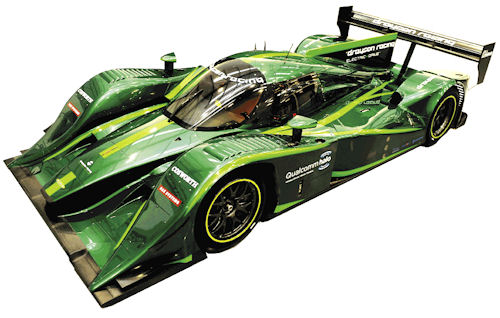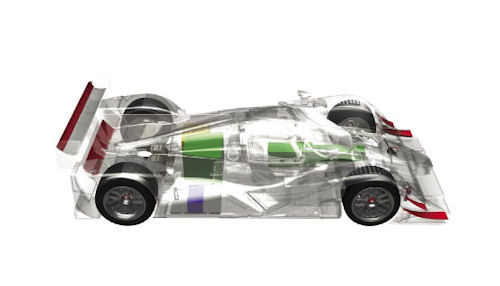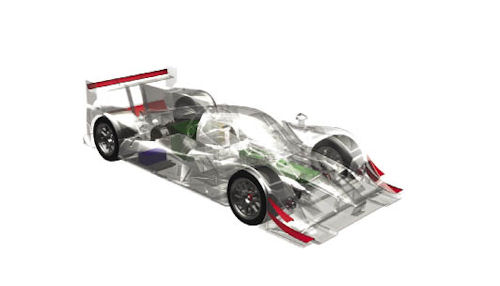Latest News
December 4, 2001
By Brian Albright
 |
| The Lola-Drayson B12/69EV is an all-electric prototype racecar constructed using new materials that include recycled composite fibers as well as natural flax-based fibers. |
Starting next year, the Federation Internationale de l’Automobile (FIA) will launch its “Formula E” championship racing series focused exclusively on electric vehicles. This convergence of motorsport and sustainability would have seemed unlikely just a few years ago.
One of the companies pushing the envelope when it comes to electric vehicle (EV) racing design has been UK-based Drayson Racing Technologies. Last year, Drayson and the Lola Group unveiled the Lola-Drayson B12/69EV, an all-electric prototype racecar built on a first-of-its-kind powertrain—and constructed, in part, using new types of composite materials developed from both natural fibers and from recycled carbon fibers.
It’s also fast, with top speeds of 200 mph and the ability to go from 0 to 60 mph in 3 seconds, or 0 to 100 mph in 5.1 seconds. Range, however, is limited. Under the Formula E race format, the electric cars will run four 15-minute heats interrupted by 30-minute recharging periods.
The design of the vehicle not only involved optimizing the usual Formula vehicle design elements of speed, power and aerodynamics, but also sustainability—both in the function of the electric motor and in the incorporation of sustainable materials within the structure.
Focus on Sustainability
What Drayson and Lola are doing is expanding the limits of EV design in ways that could have ramifications for the larger EV market.
“Our intention all along has been to push the boundaries of EV drivetrain design and provide feedback to the manufacturers so that ultimately, they are able to develop smaller motors that deliver more power,” says Graham Moore, chief engineer at Drayson Racing Technologies. “It is still very much an ongoing project, and is by no means finished yet, so there is still much to learn. Every day, we are acquiring knowledge about how the drivetrain performs in different conditions.”
Lola and Drayson weren’t starting from scratch, having already experimented with “green” racecar technology in the Lola B10/60 prototype car (with a flex fuel Judd V10 engine) in the American Le Mans Series and the Intercontinental Le Mans Cup. Since then, however, the team has been focused on developing an all-electric vehicle based on the original Lola Coupe Le Mans Prototype One (LMP1).
“The key focus was really on sustainability,” says Dr. James Meredith of the Warwick Manufacturing Group (WMG) department at the University of Warwick. Meredith’s group researched and developed the flax-based and recycled composite materials used in the car “that comes not just from the powertrain, but everything that goes in and around the car, particularly the materials that go into it.”
The final design of the vehicle marked the convergence of the R&D work done at Warwick on the composite materials, along with Drayson’s powertrain design and Lola Group’s revamped chassis. According to Drayson Racing, the initial project involved six months of intensive development, starting in July 2011. The fully assembled prototype was launched at the Low Carbon Vehicle Conference in January 2012.
Innovative Battery Technology, Drivetrain Design
The Drayson team worked with UK-based software consultant Desktop Engineering (DTE) to convert the existing vehicle design (which was powered by a 5.5-liter bio-fueled Judd engine) to a pure electric drivetrain. DTE recommended using Dassault Syst ©mes CATIA PLM Express for the process, which Drayson has credited with reducing the overall number of man-hours required for the redesign.
Drayson used the CATIA CAD package, along with the AeroLap simulation tool, to set the performance targets for the vehicle, which were based on what the team already knew about the LMP1 chassis in its original configuration. AeroLap (from Ansible Design) is a tool designed to analyze the performance of racecars over a defined path.
“Once we had our target lap performance, we knew what the power output of the drivetrain, motor sizes, inverters and batteries needed to be, and the physical/power limitations that would influence the design,” Moore says.
For Drayson, one major challenge was fitting the drivetrain to the existing vehicle design, balancing performance with optimizing the weight of the vehicle.
 |
| Engineers designed the electric drivetrain in parallel with the packing and cooling systems. |
“We had to look at different options and motors to end up with what is now a neat design and layout, which optimizes the space and manages the vehicle-to-weight ratios,” Moore says. The car weighs approximately 2,200 lbs.—or about 220 lbs. more than the original LMP1.
The electric drivetrain had to be able to support the chassis loads endured during a race, as well as during collisions. Drayson used the CATIA solution and extensive finite element analysis (FEA) so that the drivetrain could be designed in parallel with the packaging and cooling systems in a relatively short period of time.
The vehicle is powered completely by electricity stored in advanced lithium nanophosphate battery cells made by A123 Systems, and used for the first time on the Lola-Drayson EV. The cells drive the four axial flux Oxford YASA motors via inverters supplied by Rhinehart. The motors—which generate more than 850 peak hp—power the rear wheels only.
YASA also developed a new position sensor that allows two of the lightweight motors to be stacked together, which then provide 3,000Nm of torque to the wheels. Charging occurs through a HaloIPT wireless induction system (the car can be recharged when parked on a charging pad).
Cooling the motors was also a significant task, given the power-to-weight ratio of the motors. Drayson used CATIA to determine the optimal layout without significantly increasing weight or affecting strength and safety. The company is using dual water and air circuits to cool the systems.
Structural Batteries Incorporated into Chassis
According to Lola Group, the structure of the EV from the rear bulkhead forward is identical to the original LMP1, with most of the changes occurring under the rear bodywork.
Lola leveraged its own in-house CAD, FEA and computational fluid dynamics (CFD) capabilities in the revamped design. The company uses CATIA software on CAD/CAM workstations and a CFD suite that includes ANSYS Fluent, BETA CAE’s ANSA, Optimal Solutions’ Sculptor, and Intelligent Light’s FieldView for post-processing and visualization.
 |
In addition, the company has its own 50% scale moving ground plane wind tunnel, proprietary simulation software, and a seven-post test rig for full-size vehicles.
Lola’s wind tunnel capabilities assisted in the development of a key vehicle element: moveable aerodynamic surfaces on the front wheel screen flaps, rear panel, and on the rear wing. Drivers can control the position of these surfaces using electric actuators to boost downforce or reduce drag while operating the vehicle. Once the drivers have mastered controlling the active aerodynamics, the companies expect a drag reduction of up to 30%.
The rear wing is also home to another innovation: “structural batteries” developed by BAE Systems that power the onboard electronics. These batteries combine nickel-based battery chemistry with a carbon-fiber composite structure that can be formed into any shape and used as part of the actual chassis of the vehicle. This not only helps optimize weight reduction, it can also increase energy storage capacity in later versions of the car (currently, the BAE technology cannot provide enough power to run the motors).
Recycled and Natural Composites
Creating a truly “green” vehicle meant incorporating sustainable materials as well. The recycled composites used in the vehicle emerged from research and development conducted with the WMG at the University of Warwick, Umeco, and ELG Carbon Fibre. By recycling carbon fibers, companies can reduce landfill costs, reduce the environmental impact of the fibers (which do not decompose naturally), and reduce carbon composite scrap levels that ELG estimates at levels of up to 40%, depending on the industry.
For the Lola-Drayson vehicle, carbon fibers from out-of-life MTM49 epoxy prepreg were reclaimed by ELG and re-impregnated with Umeco’s MTM49 toughened epoxy resin.
WMG, Lola and Umeco performed extensive physical testing to determine the mechanical and impact properties of the material, comparing them against virgin prepregs.
“We did a lot of pulling, squashing and bending,” Meredith says. “We made test cones and put them on a drop rig, and smashed them into the ground to analyze their specific energy absorption.”
Those tests showed minimal loss of strength and similar fiber stiffness. There was no computer simulation or modeling during that phase, because as Meredith says, the team was trying to “establish and obtain the values to determine the key performance of the materials under different circumstances.”
The flax-reinforced composite development also came out of the Umeco/WMG partnership, this time in conjunction with Composites Evolution. WMG worked with the Engineering and Physical Sciences Research Council and Warwick Innovative Manufacturing Research Center (WIMRC) on the testing, while Composites Evolution provided the woven flax material, which Umeco again impregnated with its MTM28 and MTM49 epoxy resins.
The advantage of flax fibers: They have similar mechanical properties to glass fibers, but at a lower weight and with less environmental impact. They also have good vibration damping and insulating characteristics.
“They require essentially no energy to produce, they are very easy to work with, they’re non-toxic, and they are biodegradable,” Meredith says. “They can also be burned for energy with no theoretical CO2 gain.”
Initially, the recycled bodywork parts will be non-structural (sidepods, damper hatches, etc.), but the company hopes to expand their use after further refinement and testing. Drayson is waiting to see how these parts perform during actual races, and will continue to gather data and work with the Warwick group to refine the materials.
“]The new composites] haven’t been used in safety critical areas, so it is early to predict,” Moore says. “Our understanding of how they will perform is very much a work in progress.”
Design Tweaks Continue
The B12/69EV completed its first track run at the Goodwood Festival of Speed earlier this year, placing 11th overall and setting a festival record (53.91 seconds) for an electric vehicle on a hillclimb.
Drayson and Lola have continued to work on the vehicle’s design. They perform tests on the battery technologies and active aerodynamics as they prepare for the first Formula E events next year. As far as the recycled composites, Meredith says WMG is looking at ways to better utilize short fibers and the longer fibers that come from out-of-life components, which he describes as a “tangled mess.”
Now that some baseline information about the properties of the material exists, Meredith says the team can begin to use modeling to develop more complex objects (at WMG, the researchers use SolidWorks, CATIA, and Genesis FEA from VR&D).
“We’ve been able to set a benchmark for what was possible,” Meredith says. “Now we are thinking about how we might improve in the future.”
Brian Albright is a freelance journalist based in Columbus, OH. He is the former managing editor of Frontline Solutions magazine, and has been writing about technology topics since the mid-1990s. Send e-mail about this article to [email protected].
INFO
Subscribe to our FREE magazine, FREE email newsletters or both!
Latest News
About the Author
Brian Albright is the editorial director of Digital Engineering. Contact him at [email protected].
Follow DE




